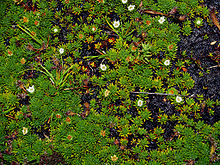- Donatia
-
Donatia 
Donatia novae-zelandiae Scientific classification Kingdom: Plantae (unranked): Angiosperms (unranked): Eudicots (unranked): Asterids Order: Asterales Family: Donatiaceae
(Mildbr.) Skottsb.Genus: Donatia
J.R.Forst. & G.Forst.Species Donatia fascicularis
Donatia novae-zelandiaeDonatia is a genus of two cushion plant species in the monogeneric family Donatiaceae. In the past, Donatia has been placed in the subfamily Donatioideae, described by Johannes Mildbraed in his 1908 taxonomic monograph of the family Stylidiaceae. The subfamily was created to distinguish the difference between the single genus Donatia from the five typical genera of the Stylidiaceae that Mildbraed placed in the Stylidioideae subfamily.[1] The subfamily taxonomy represented the taxonomic uncertainty of Donatia, which had at one point also been placed in the Saxifragaceae.[2][3] Donatia differs sufficiently from the genera in the Stylidiaceae in that it has free stamens and petals, paracytic stomata, and a pollen morphology distinct from the other genera. Because of this and the recent phylogenetic analysis based on rbcL genes, more recent treatments have segregated Donatia into its own family, the Donatiaceae. The molecular phylogenetic analysis has placed Donatia as a sister-group to Stylidiaceae, thus leaving the Stylidiaceae as a monophyletic family.[4][5]
 Drawing of Donatia fascicularis from the Endeavour voyage of James Cook in 1769.
Drawing of Donatia fascicularis from the Endeavour voyage of James Cook in 1769.
As early as 3 years after Mildbraed's publication of the subfamily Donatioideae, other authors began to question the placement and argued for recognition of Donatiaceae. In 1915, Carl Skottsberg formally published the Donatiaceae.[6] The APG II system recommends the inclusion of Donatia in Stylidiaceae but allows for the optional recognition of the family Donatiaceae. The two species in the genus represent a wide geographic range. D. novae-zelandiae is found in the alpine and subalpine regions of New Zealand and Tasmania while D. fascicularis is native to similar habitats in southern South America to latitude 40°S.[2]
References
- ^ Mildbraed, J. (1908). Stylidiaceae. In Engler, A. Das Pflanzenreich: Regni vegetabilis conspectus, IV. 278. Leipzig, 1908.
- ^ a b Wagstaff, S.J. and Wege, J. (2002). Patterns of diversification in New Zealand Stylidiaceae. American Journal of Botany, 89(5): 865-874.
- ^ Good, R. (1925). On the geographical distribution of the Stylidiaceae. New Phytologist, 24(4): 225-240.
- ^ Laurent, N., Bremer, B., and Bremer, K. (1999). Phylogeny and generic interrelationships of the Stylidiaceae (Asterales), with a possible extreme case of floral paedomorphosis. Systematic Botany, 23(3): 289-304.
- ^ Lundberg, J. and Bremer, K. (2003). A phylogenetic study of the order Asterales using one morphological and three molecular data sets. International Journal of Plant Science, 164: 553-578.
- ^ Skottsberg, C. (1915). Notes on the relations between the floras of subantarctic America and New Zealand. Plant World, 18: 129-142.

This Asterales article is a stub. You can help Wikipedia by expanding it.
